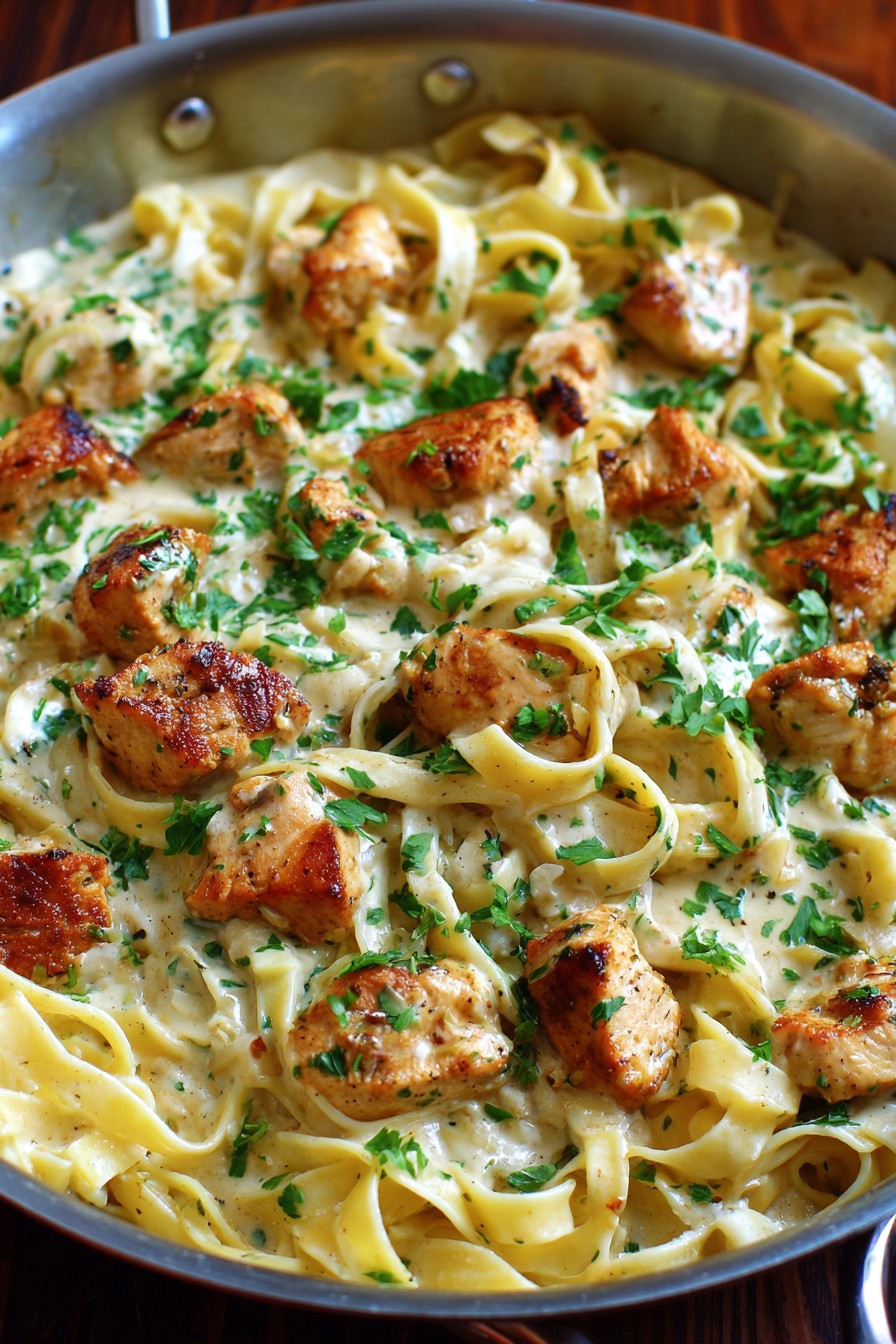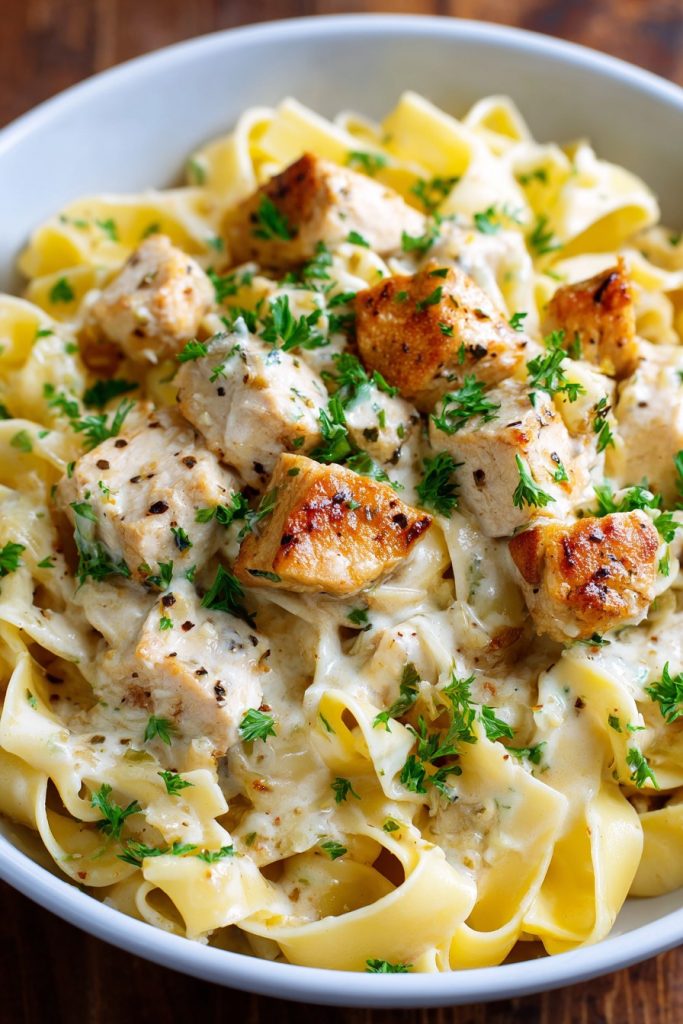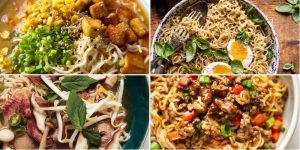Just when you thought weeknight dinners had to be boring, this white sauce chicken pasta swoops in to save the day! Jump into a bowl of pure comfort that’s surprisingly easy to make and guaranteed to become a family favorite faster than you can say “more Parmesan, please!”
Why This Recipe Works
- The combination of butter, flour, and whole milk creates a velvety smooth sauce that clings perfectly to every pasta strand without being overly heavy or greasy
- Using boneless, skinless chicken breasts cooked to exactly 165°F ensures tender, juicy protein that absorbs the creamy sauce beautifully while maintaining perfect food safety standards
- Freshly grated Parmesan cheese melts seamlessly into the sauce, providing a nutty, salty depth that pre-shredded cheese can’t match due to anti-caking agents
- The quick 12-minute pasta cook time in generously salted water means your noodles come out al dente with just enough bite to stand up to the rich sauce
- Finishing with fresh parsley and black pepper adds brightness and complexity that elevates this from simple comfort food to something truly special
Ingredients
- 12 ounces fettuccine pasta
- 1 pound boneless, skinless chicken breasts, cut into 1-inch cubes
- 4 tablespoons unsalted butter
- 3 cloves garlic, minced
- 1/4 cup all-purpose flour
- 3 cups whole milk, warmed
- 1 cup freshly grated Parmesan cheese
- 1/2 teaspoon ground nutmeg
- 1/4 cup fresh parsley, chopped
- 2 tablespoons olive oil
- Salt and black pepper to taste
Equipment Needed
- Large pot for boiling pasta
- Large skillet or Dutch oven
- Wooden spoon or whisk
- Measuring cups and spoons
- Cheese grater
- Cutting board and chef’s knife
- Instant-read thermometer
- Colander
Instructions

Prepare Your Pasta Base
Fill a large pot with 4 quarts of water and bring it to a rolling boil over high heat—you’ll know it’s ready when large bubbles continuously break the surface. Add 2 tablespoons of salt to the water (this is your only chance to season the pasta itself!) and then carefully add the fettuccine. Stir immediately to prevent sticking and cook for exactly 12 minutes, which should give you perfectly al dente pasta. Reserve 1 cup of the starchy pasta water before draining—this liquid gold will help your sauce cling to the noodles later. Drain the pasta in a colander but do not rinse, as the starch helps the sauce adhere better.
Cook the Chicken to Perfection
While your pasta cooks, pat the chicken cubes completely dry with paper towels—this is crucial for achieving that beautiful golden brown color rather than steaming. Heat 2 tablespoons of olive oil in a large skillet over medium-high heat until it shimmers, about 2 minutes. Add the chicken in a single layer without crowding (work in batches if needed) and season generously with salt and pepper. Cook for 4-5 minutes per side until the exterior develops a golden-brown crust and the internal temperature reaches exactly 165°F when tested with an instant-read thermometer. Remove the chicken from the skillet and set aside—it will finish cooking slightly while resting.
Create the Roux Foundation
Reduce the heat to medium and add 4 tablespoons of butter to the same skillet, scraping up any browned bits from the chicken—those little flavor bombs will make your sauce incredible! Once the butter melts and stops foaming, add the minced garlic and cook for just 30 seconds until fragrant but not browned. Sprinkle in the 1/4 cup of flour and immediately whisk continuously for exactly 2 minutes—this cooks out the raw flour taste while creating the base for your sauce. The mixture should form a smooth paste (called a roux) that turns a light golden color and smells slightly nutty.
Transform into Creamy Sauce
Slowly pour in the warmed milk while whisking constantly—starting with warm milk prevents lumps from forming! Continue whisking for about 3-4 minutes until the sauce thickens enough to coat the back of a spoon. Reduce the heat to low and stir in the freshly grated Parmesan cheese until completely melted and smooth, about 2 minutes. Add the ground nutmeg, which might seem unusual but provides a warm, subtle complexity that cuts through the richness. Season with salt and pepper to taste—remember the Parmesan is salty, so taste first!
Bring It All Together
Add the cooked pasta and chicken back to the skillet with the sauce, tossing gently to combine everything evenly. If the sauce seems too thick, add the reserved pasta water a tablespoon at a time until it reaches your desired consistency—the starch in the water helps create a silky texture. Cook for just 1-2 more minutes over low heat to allow the flavors to meld together beautifully. Remove from heat and stir in the fresh parsley right before serving for a pop of color and freshness.
Tips and Tricks
For the absolute creamiest sauce, consider using half heavy cream and half whole milk—the higher fat content creates an incredibly luxurious texture that’s worth the extra calories for special occasions. Always grate your Parmesan cheese fresh from a block rather than using pre-shredded varieties, as the anti-caking agents in pre-shredded cheese can make your sauce grainy and prevent it from melting smoothly. If you’re making this ahead of time, prepare the components separately and combine them just before serving, as the pasta will continue to absorb the sauce and may become too thick if left sitting.
For an extra flavor boost, try adding a splash of white wine to the skillet after cooking the chicken—let it reduce by half before adding the butter, which will add a wonderful depth of flavor. If you’re watching your sodium intake, you can use low-sodium chicken broth instead of salting the pasta water, and reduce the amount of Parmesan while increasing other seasonings like garlic powder or onion powder. To make this dish even quicker, use rotisserie chicken—just shred it and add it at the end to warm through, skipping the chicken cooking step entirely.
For those who love vegetables, sauté some sliced mushrooms with the garlic or add steamed broccoli florets at the end—both complement the creamy sauce beautifully. If your sauce does develop lumps despite your best efforts, don’t panic! Simply blend it with an immersion blender or strain it through a fine-mesh sieve for a perfectly smooth texture. Finally, always let your pasta rest for a minute after combining with the sauce—this allows the noodles to absorb some of the liquid and results in a better overall texture.
Recipe Variations
- For a seafood twist, substitute the chicken with 1 pound of large shrimp—add them raw to the sauce during the last 3-4 minutes of cooking until they turn pink and opaque. The shrimp will release delicious juices into the sauce, creating a briny, sophisticated version that feels fancy but comes together just as quickly. Serve with a squeeze of lemon juice and extra black pepper for a restaurant-quality dish that impresses guests.
- Transform this into a vegetarian delight by replacing the chicken with roasted vegetables—try 2 cups of chopped broccoli florets, 1 sliced red bell pepper, and 1 cup of sliced mushrooms tossed with olive oil and roasted at 400°F for 20 minutes until tender and slightly caramelized. The roasted veggies add wonderful texture and sweetness that balances the rich sauce, making it a hearty meat-free option that even carnivores will enjoy.
- Create a spicy arrabbiata version by adding 1 teaspoon of red pepper flakes to the butter with the garlic, and stirring in 1/4 cup of tomato paste after the roux forms—cook for 1 minute before adding the milk. The tomato paste adds a subtle sweetness and beautiful orange hue, while the red pepper flakes provide a pleasant heat that builds with each bite. Top with extra red pepper flakes for those who really want to turn up the heat.
- For an ultra-indulgent carbonara-style variation, whisk 2 egg yolks into the finished sauce off the heat, then immediately add the hot pasta and chicken—the residual heat will cook the eggs into a silky, rich coating. Add crispy cooked bacon or pancetta pieces and extra black pepper for that classic carbonara flavor profile that feels incredibly decadent but still maintains the creamy white sauce base.
Frequently Asked Questions
Can I use a different type of pasta?
Absolutely! While fettuccine is classic for creamy sauces, penne, rigatoni, or farfalle work beautifully too—just adjust the cooking time according to package directions. The key is choosing pasta with shapes that can hold the sauce—ridged or hollow pastas are excellent because they trap the creamy goodness in every bite. Avoid very delicate pastas like angel hair, as they can become mushy under the weight of the sauce. Whatever shape you choose, always reserve some pasta water to adjust the sauce consistency at the end.
How do I prevent my sauce from becoming grainy?
Graininess usually comes from overheating the sauce after adding cheese or using pre-shredded Parmesan with anti-caking agents. Always remove the skillet from heat before stirring in the cheese, and use the residual heat to melt it gently. Freshly grate your Parmesan from a block rather than using pre-shredded, as the cellulose coating on pre-shredded cheese doesn’t melt smoothly. If your sauce does break or become grainy, whisk in a tablespoon of cold butter off the heat—the emulsifiers can often bring it back together.
Can I make this dish ahead of time?
You can prepare components ahead, but I don’t recommend combining them until just before serving. Cook the pasta and toss it with a little olive oil to prevent sticking, then store separately from the sauce. The sauce will thicken significantly when refrigerated—thin it with milk when reheating. The chicken can be cooked up to 3 days ahead. When ready to serve, reheat everything separately and combine with a splash of milk or pasta water to bring it back to the right consistency.
What’s the best way to reheat leftovers?
Reheat gently on the stovetop over low heat with a splash of milk or cream, stirring frequently—the microwave can make the sauce separate and the pasta rubbery. If the sauce seems too thick, add liquid a tablespoon at a time until it reaches the desired consistency. The pasta will have absorbed much of the sauce, so you’ll need more liquid than you might expect. For best results, enjoy within 2-3 days—the quality declines after that as the pasta continues to soften.
Can I freeze this pasta dish?
I don’t recommend freezing completed pasta dishes with cream sauces, as the dairy can separate and the pasta becomes mushy upon thawing. However, you can freeze the sauce alone for up to 3 months—prepare it without the pasta and chicken, cool completely, then freeze in airtight containers. Thaw overnight in the refrigerator, then reheat gently while whisking, adding a little milk if needed. Cook fresh pasta and chicken to combine with the thawed sauce for best results.
Summary
This white sauce chicken pasta delivers restaurant-quality creaminess in under 30 minutes, featuring tender chicken, al dente pasta, and a luxuriously smooth Parmesan sauce that will have everyone begging for seconds. Perfect for busy weeknights yet impressive enough for company!
White Sauce Chicken Pasta
5
servings10
minutes20
minutesIngredients
Instructions
- 1 Cook pasta in salted boiling water for 12 minutes, reserve 1 cup pasta water, then drain
- 2 Cook chicken in olive oil over medium-high heat until golden brown and internal temperature reaches 165°F
- 3 Make roux with butter, garlic, and flour, whisking for 2 minutes until golden
- 4 Gradually whisk in warm milk until thickened, then stir in Parmesan and nutmeg off heat
- 5 Combine pasta, chicken, and sauce, thinning with reserved pasta water if needed, then stir in parsley



